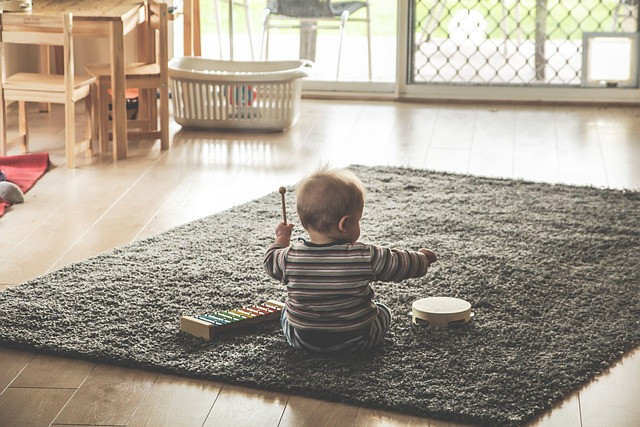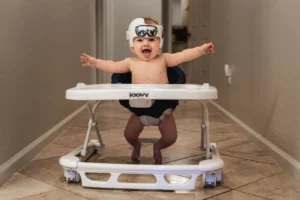
Your baby at 8 months old will have much improved leg and foot power, so would be pushing to move around and explore.
He would venture to go around exploring, crawling up a storm. He/she would be crawling forwards
and backwards, andpulls himself to standing, although he will find it much hard than anticipated.
He/she will be engaged in a moresophisticated interactions and play. Will be quick to get himself
into a sitting position from being placed on a stomach.
Voluntarily opens and closes hands. Use fingers and thumb in a pincer grip, or rakes a raisin and
pick it up in fist. He/shewould pull himself to stand holding on to someone or something from a
sitting position.
Learning
He/she will be more alert for a longer period and may manage only one nap a day.
Your baby ‘s curiosity is increased, and would discover new properties in a familiar toy, and would
prefer to play with two ormore toys together Would be able to recognize a toy not seen for sometime,
and would look for a concealed object.He/she would like to drop objects when sitting on a chair or is
confined in a playpen. Makes an effort to reach objectssome distance away. The method a baby
chooses to get from one point to another is much less important than the factthat he is making an
effort to achieve independent mobility. Tom encourage him to move forward, try putting a favorite
toy or interesting object a short distance ahead of him.
Contain the chaos
Messy must be your worst enemy, but it’s a curious baby’s best friend. Letting your baby roam – and
mess- freely is asimportant to his intellectual growth as it is to his physical development. Accepting
this reality is important to your mentalhealth. Parents of young children who fight it, struggling to
keep the house as neat as it was pre-baby, are in for adisappointment – as well as overwhelming
frustration and anxietyYou can, however, take some steps, to make coping with reality easier.. Before
you make the baby loose, be sure to makethe house safe.
Confine the mess to one area in the home. That means letting your baby have free run, wherever you
and your baby spendthe most time together.
Don’t follow your baby around as he creates chaos, putting away everything that he takes out. This
will frustrate him, givinghim, giving him the sense that everything he does is not only unacceptable
but totally in vain. And it will frustrate you if hedoes the same damage that you have just undone.
Teach him neatness
This is the age when you can start to teach your baby neatness. Pick up a couple of things with him at
the end of eachsession repeatedly. Hand him one of the blocks to put back into the toy chest, give
him some crumpled paper to throw into
the wastebasket, not forgetting to praise him for his effort. He/she will be messing up a lot more
often than he can clean,the early lesson will help him understand – eventually – that what comes out
must go back in. Though it’s healthy for a babyto be allowed to make a mess, it is not healthy for him
to always be surrounded by disorder. It will give him a sense ofsecurity to know that even though he
leaves an untidy world at bedtime, it will be returned to order when he wakes up inthe morning.
The Use of Playpen
Few months ago, playpen is your baby’s personal amusement park. It does not seem confining then.
The four walls thatwas once his world of fun, now represents a frustrating barrier to him, keeping
him on the inside looking out. He isbeginning to realize that there is a better place than his playpen.
This is the time that he/she uses the playpen as an emergency resort, such as when you need to go to
the bathroom, putsomething aside, a quick tasks that you need to attend to. Limit his time in to the
pen less than fifteen minutes. As you do
this repeatedly, he will get the understanding that the pen confinement is temporary

Language
This is the age that your baby will echo whatever he hears from you. He/she will imitate the sounds
you make. Repeats thesame sounds over and over, such as syllables of words you use. Screams for
attention. Would enjoy the sound of nurserymusic and would want to hear it again and again.
Reading to Your Baby
There is always value in reading to a baby while still in your belly. Many parents would begin reading
to their babieimmediatelyafter birth. You would find it amusing how your baby woukd pay attention
to the words when you read to them(at this point, to the rhythm and sounds of the words rather than
their meanings) and to the illustrations (enjoying the colorsand the patterns
Illustration books that include bold, bright, realistic pictures of familiar objects, animals, toys,
children.
Vinyl books that are good for bath time.
Activity tie-ins. Books that stimulate games like peek-a-boo, touch-and-feel books that encourage
learning about textures,
and books that have surprises hidden under little flaps encourages curiosity and participation.
Build reading to your baby – part of the baby agenda at least twice a day. But keep the schedule only
if the baby isreceptive.
Social and Emotional
He/she enjoys being in the presence of other babies, but engages in parallel play, does not play
cooperatively with them.
May be shy or reluctant to be picked up by strangers. Clings to parents in crowded places. May
answer simple questionsby facial expressions, body movements and sounds. Fascinated by mirror
images, and family photographs. May initiatesocial contacts with other adults.

I want you to feel that you can reach out to me if ever you have questions or want to share ideas that you have related to the care of babies, growing premature babies, and the overall health issues pertaining to the care of babies OR just drop me a comment to just say “Hello” or “what’s up”.
All The Best,
Maria Teresa
BabiesBuddies.com



